| Listing 1 - 10 of 10 |
Sort by
|
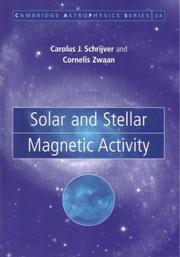
ISBN: 1107113954 0511009607 1280418699 9786610418695 0511172486 0511151292 0511302045 0511546033 0511053991 9780511009600 0511038755 9780511038754 9780521582865 0521582865 6610418691 0521582865 9781107113954 9781280418693 9780511172489 9780511151293 9780511302046 9780511546037 9780511053993 0521739861 9780521739863 Year: 2000 Publisher: Cambridge Cambridge University Press
Abstract | Keywords | Export | Availability | Bookmark
 Loading...
Loading...Choose an application
- Reference Manager
- EndNote
- RefWorks (Direct export to RefWorks)
This timely volume provides the first comprehensive review and synthesis of current understanding of magnetic fields in the Sun and similar stars. Magnetic activity results in a wealth of phenomena - including starspots, non-radiatively heated outer atmospheres, activity cycles, deceleration of rotation rates, and even, in close binaries, stellar cannibalism - all of which are covered clearly and authoritatively. This book brings together for the first time recent results in solar studies and stellar studies. The result is an illuminating new view of stellar magnetic activity. Key topics include radiative transfer, convective simulations, dynamo theory, outer-atmospheric heating, stellar winds and angular momentum loss. Researchers are provided with a state-of-the-art review of this exciting field, and the pedagogical style and introductory material make the book an ideal and welcome introduction for graduate students.
Solar magnetic fields. --- Stars --- Magnetism, Stellar --- Stellar magnetic fields --- Stellar magnetism --- Cosmic magnetic fields --- Heliomagnetism --- Magnetism, Solar --- Solar magnetic field --- Solar magnetism --- Magnetic fields. --- Magnetic fields --- Solar physics

ISBN: 0471322059 Year: 2000 Publisher: New York : Wiley,
Abstract | Keywords | Export | Availability | Bookmark
 Loading...
Loading...Choose an application
- Reference Manager
- EndNote
- RefWorks (Direct export to RefWorks)
Magnetic fields. --- Champs magnétiques --- Champs magnétiques
Book
Year: 2000 Publisher: New York : Institute of Electrical and Electronics Engineers,
Abstract | Keywords | Export | Availability | Bookmark
 Loading...
Loading...Choose an application
- Reference Manager
- EndNote
- RefWorks (Direct export to RefWorks)
Champs magnétiques --- Champs magnétiques --- Champs électromagnétiques --- Magnetic fields --- Magnetic fields. --- Congrès. --- Congrès.
Book
Year: 2000 Publisher: London Royal Society
Abstract | Keywords | Export | Availability | Bookmark
 Loading...
Loading...Choose an application
- Reference Manager
- EndNote
- RefWorks (Direct export to RefWorks)
Stars --- Disks (Astrophysics) --- Quasars --- Atmospheres --- Solar magnetic fields
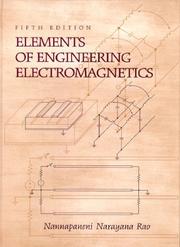
ISBN: 0130132012 9780130132017 Year: 2000 Publisher: Upper Saddle River Prentice Hall
Abstract | Keywords | Export | Availability | Bookmark
 Loading...
Loading...Choose an application
- Reference Manager
- EndNote
- RefWorks (Direct export to RefWorks)
Electromagnetic theory --- Light, Electromagnetic theory of --- Electric fields --- Magnetic fields --- Electromagnetic theory.
Book
Year: 2000 Publisher: Aberdeen Proving Ground, MD : Army Research Laboratory,
Abstract | Keywords | Export | Availability | Bookmark
 Loading...
Loading...Choose an application
- Reference Manager
- EndNote
- RefWorks (Direct export to RefWorks)
Guided missiles --- Magnetic fields --- Projectiles. --- Control systems. --- Measurement --- Equipment and supplies.
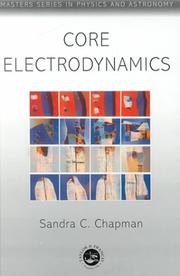
ISBN: 0748406239 9780748406234 0748406220 9780748406227 Year: 2000 Publisher: London Taylor & Francis
Abstract | Keywords | Export | Availability | Bookmark
 Loading...
Loading...Choose an application
- Reference Manager
- EndNote
- RefWorks (Direct export to RefWorks)
"Core Electrodynamics is written in concise form to engage the reader in the elegance of electrodynamics and special relativity, while retaining sufficient rigour for graduate study." "From the basis of experiment the Maxwell equations and special relativity are first derived. The mathematical framework of generalized tensors is then introduced and the laws of mechanics, the Lorentz force and the Maxwell equations are cast in manifestly covariant form. This provides the basis for graduate study in field theory, high energy astrophysics and quantum electrodynamics."--Jacket.
Electromagnetic theory --- 537.8 --- 537.8 Electromagnetism. Electromagnetic field. Electrodynamics. Maxwell theory --- Electromagnetism. Electromagnetic field. Electrodynamics. Maxwell theory --- Light, Electromagnetic theory of --- Electric fields --- Magnetic fields --- Electromagnetism. Ferromagnetism
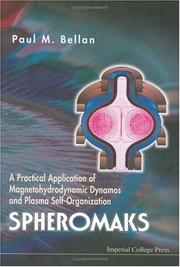
ISBN: 1848160569 9781848160569 1860941419 9781860941412 Year: 2000 Publisher: London Imperial College Press
Abstract | Keywords | Export | Availability | Bookmark
 Loading...
Loading...Choose an application
- Reference Manager
- EndNote
- RefWorks (Direct export to RefWorks)
Spheromaks are easily formed, self-organized magnetized plasma configurations that have intrigued plasma physicists for over two decades. Sometimes called magnetic vortices, magnetic smoke rings, or plasmoids, spheromaks first attracted attention as a possible controlled thermonuclear plasma confinement scheme, but are now known to have many other applications.This book begins with a review of the basic concepts of magnetohydrodynamics and toroidal magnetic configurations, then provides a detailed exposition of the 3D topological concepts underlying spheromak physics, namely magnetic helicity,
Plasma confinement. --- Magnetohydrodynamics. --- Magnetic reconnection. --- Annihilation, Magnetic field --- Magnetic field annihilation --- Magnetic field line merging --- Merging, Magnetic field line --- Reconnection, Magnetic --- Reconnection (Astronomy) --- Astrophysics --- Geophysics --- Magnetic fields --- Magneto-hydrodynamics --- MHD (Physics) --- Fluid dynamics --- Plasma dynamics --- Confined plasma --- Confinement of plasma --- Plasma, Confined --- Plasma containment --- Plasma control --- Plasma isolation --- Containerless processing --- Controlled fusion --- High temperature plasmas --- Pinch effect (Physics) --- Plasma confinement --- Magnetohydrodynamics --- Magnetic reconnection
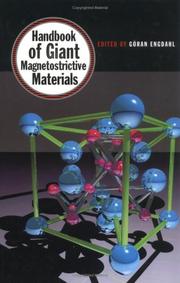
ISBN: 9780122386404 012238640X 9780080533605 0080533604 1281038180 9781281038180 9786611038182 Year: 2000 Publisher: San Diego, CA : Academic Press,
Abstract | Keywords | Export | Availability | Bookmark
 Loading...
Loading...Choose an application
- Reference Manager
- EndNote
- RefWorks (Direct export to RefWorks)
Handbook of Giant Magnetostrictive Materials contains the knowledge that a mechanical or an electrical engineer needs when considering the use of magnetostrictive materials in a construction project. The book covers the physical origin of giant magnetostriction, its manufacturing and metallurgy, and grain related processes under operation. Comprehensive descriptions of useful models of design methods and tools are given, including the performance of devices and systems comprised of magnetostrictive materials, considering the electrical, magnetic, mechanical, and thermal effects. The
Smart materials --- Magnetostrictive transducers --- Thin film devices --- Electromagnetic fields. --- Magnetostriction. --- Materials science. --- Material science --- Physical sciences --- Magnetoelasticity --- Magnetostriction constant --- Magnetostriction saturations --- Negative magnetostriction --- Positive magnetostriction --- Magnetism --- Fields, Electromagnetic --- Magnetic fields --- Electric fields --- Devices, Thin film --- Electronic apparatus and appliances --- Thin films --- Transducers --- Adaptive materials --- Intelligent materials --- Sense-able materials --- Materials --- Mechanical properties. --- Materials.
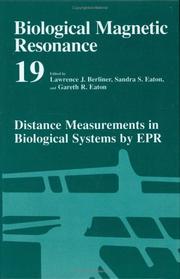
ISBN: 0306465337 1475705751 0306471094 Year: 2000 Publisher: New York Kluwer
Abstract | Keywords | Export | Availability | Bookmark
 Loading...
Loading...Choose an application
- Reference Manager
- EndNote
- RefWorks (Direct export to RefWorks)
Distance measurements in biological systems by EPR The foundation for understanding function and dynamics of biological systems is knowledge of their structure. Many experimental methodologies are used for determination of structure, each with special utility. Volumes in this series on Biological Magnetic Resonance emphasize the methods that involve magnetic resonance. This volume seeks to provide a critical evaluation of EPR methods for determining the distances between two unpaired electrons. The editors invited the authors to make this a very practical book, with specific numerical examples of how experimental data is worked up to produce a distance estimate, and realistic assessments of uncertainties and of the range of applicability, along with examples of the power of the technique to answer biological problems. The first chapter is an overview, by two of the editors, of EPR methods to determine distances, with a focus on the range of applicability. The next chapter, also by the Batons, reviews what is known about electron spin relaxation times that are needed in estimating distances between spins or in selecting appropriate temperatures for particular experiments. Albert Beth and Eric Hustedt describe the information about spin-spin interaction that one can obtain by simulating CW EPR line shapes of nitroxyl radicals. The information in fluid solution CW EPR spectra of dual-spin labeled proteins is illustrated by Hassane Mchaourab and Eduardo Perozo.
Theoretical spectroscopy. Spectroscopic techniques --- fysicochemie --- Organic spectroscopy --- Magnetic resonance. --- Radiology, Medical. --- Biochemistry. --- Chemistry, Physical organic. --- Imaging / Radiology. --- Biochemistry, general. --- Biological and Medical Physics, Biophysics. --- Atomic, Molecular, Optical and Plasma Physics. --- Physical Chemistry. --- Electron paramagnetic resonance. --- Radiology. --- Biophysics. --- Biological physics. --- Atoms. --- Physics. --- Physical chemistry. --- Chemistry, Theoretical --- Physical chemistry --- Theoretical chemistry --- Chemistry --- Natural philosophy --- Philosophy, Natural --- Physical sciences --- Dynamics --- Chemistry, Physical and theoretical --- Matter --- Stereochemistry --- Biological physics --- Biology --- Medical sciences --- Physics --- Biological chemistry --- Chemical composition of organisms --- Organisms --- Physiological chemistry --- Radiological physics --- Radiation --- Constitution --- Composition --- Resonance, Magnetic --- Atoms --- Magnetic fields --- Nuclear spin --- Electron resonance --- Electron spin resonance --- EPR (Magnetic resonance) --- ESR (Magnetic resonance) --- Paramagnetic resonance, Electron --- Magnetic resonance --- Paramagnetism
| Listing 1 - 10 of 10 |
Sort by
|

 Search
Search Feedback
Feedback About UniCat
About UniCat  Help
Help News
News